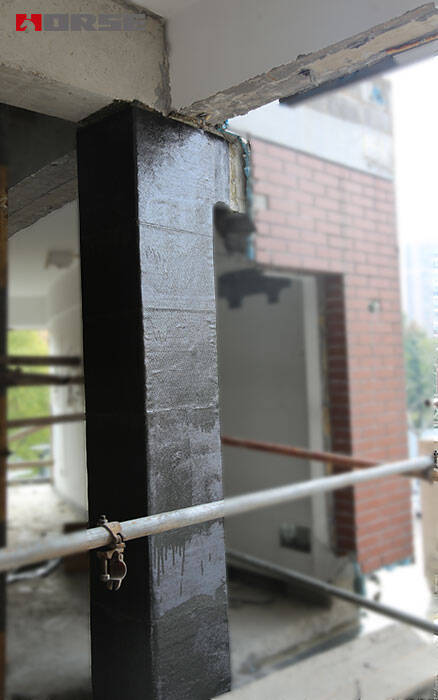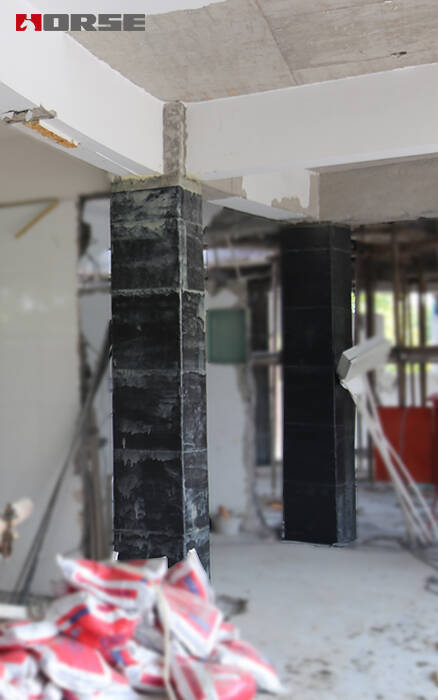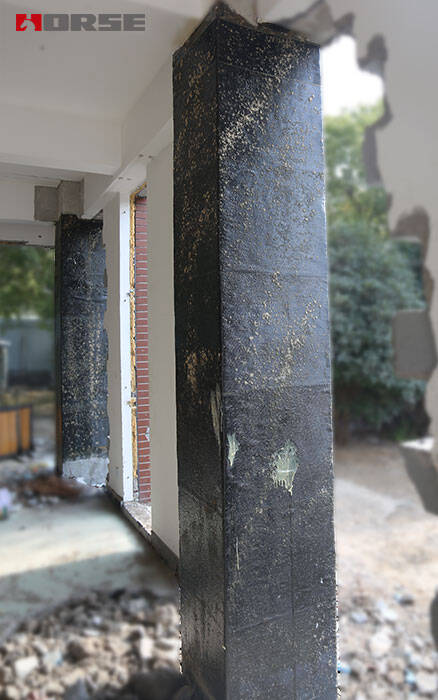Solutions
Horse Construction offers full range of structural strengthening materials with technical supports, documentation supports, products supports, project supports.
With the development of social economy in China, the scale and quantity of civil engineering projects are increasing. As a new type of material, FRP(fiber reinforced polymer) composites have been widely used in civil construction and infrastructure engineering

With the development of social economy in China, the scale and quantity of civil engineering projects are increasing. As a new type of material, FRP(fiber reinforced polymer) composites have been widely used in civil construction and infrastructure engineering because of their low density, high strength, high temperature resistance and corrosion resistance. The application of CFRP in infrastructure and civil buildings is analyzed in this paper.
The application of CFRP materials in infrastructure and civil buildings mainly has the following characteristics:
First, CFRP materials are designed. When fiber composites or CFRP are used as structural materials, because it is a combination of reinforced materials and matrix materials, it can not only maintain some characteristics of the original material, but also play a new role after the combination. It can be designed according to the needs of the structure, so as to meet some performance requirements that a single material can not meet.
Two, CFRP is characterized by high strength and light weight. Its tensile strength is relatively high, compared with ordinary steel bar, along the fiber direction of tensile strength is much greater, of course, its uniformity is slightly worse than steel, and anisotropy, so that the shear strength and the strength of multi-axial force is also lower. Its quality is very light, the density is only 1/5 of the density of steel, in the construction and installation is more convenient;
The three is fatigue resistance and corrosion resistance. Usually the fatigue strength of steel bar and other metals is about 50% of the tensile strength, but the fatigue strength of fiber reinforced composites is generally more than 70% of the tensile strength, which has a good anti-fatigue function. General building materials, such as steel bars, are not corrosion-resistant, especially in offshore projects, and the surrounding air, chemicals and seawater are easy to react, so that infrastructure construction and civil engineering can not play its due role effectively, resulting in greater losses. CFRP and other fiber composites have better corrosion resistance. The equipment and components made of CFRP have better corrosion resistance to chemical substances such as alkali, acid and salt.
Four, the seismic performance and safety performance is better. Compared with the original building materials, CFRP materials have higher natural frequencies, no resonance, and basically no rapid fracture due to resonance under the loading frequency and speed. And in the fiber composites, there are more independent fibers, if the composite material overload will not occur immediately fiber fracture. Even if there is a small amount of fiber breakage, the load will be redistributed to other undamaged fibers, thus preventing the infrastructure and civil engineering components from losing the load-bearing capacity of the moment of fracture;
Five, it has a strong aesthetic appreciation plasticity. CFRP material is relatively soft, the shape of the product is basically unlimited, can be arbitrary coloring, the structural form and material aesthetics are unified.

1. CFRP can enhance the application of concrete.
In infrastructure and civil construction, concrete is an indispensable application materials, and the use of a very large amount. Usually, steel bars are used to increase strength, but steel bars themselves are generally vulnerable to acid-alkali corrosion, but also cause certain damage to the concrete, which requires the search for new concrete products. In this case, fiber concrete arises at the historic moment, which is the innovation of concrete. Glass fiber, steel fiber and vinylon were first used to reinforce concrete, but CFRP is now generally used to reinforce concrete. The modulus, strength, fracture length and spatial structure of fiber materials determine the properties of concrete. The application of CFRP material can enhance the tensile strength, crack resistance and bending strength of concrete, and can be used as decorative materials, wall panels, wall panels and main buildings. The original concrete structure has deterioration and corrosion problems, especially steel corrosion is the most common, and there will be safety incidents, and then the use of steel fiber. The steel fiber has high cost and easy corrosion. Its application is relatively limited. Later, the tensile strength of glass fiber is much better than steel bar, and the weight is only 1/4 of the weight of steel bar, by sea water and cement erosion is much lower than steel bar, but glass fiber has the characteristics of easy breaking and alkali resistance, and the application of pollution. CFRP concrete is widely used because of its high strength, low density and high hardness, high modulus of elasticity and tensile strength, high conductivity, high temperature resistance, wear resistance, and good bonding with concrete. Of course, some of the buildings can not be applied because of their magnetic conductivity. For example, Japanese scholars use fiber felt as a component of absorbing electromagnetic wave function to carry out lightweight and shock-proof curtain wall. This kind of CFRP material can not only shield electromagnetic waves, but also can be used in traffic intelligent systems. Many advantages of CFRP material make it popular in civil construction and infrastructure construction.
2. Application of CFRP in structural reinforcement materials
CFRP materials are mainly used in reinforcing materials for infrastructure and civil engineering structures. The original reinforcement material is mainly steel plate, with self-weight, easy aging, poor corrosion resistance and construction inconvenience and other shortcomings. At present, the reinforcement materials used are generally CFRP materials, generally more suitable for reinforced concrete structural changes, lack of strength, cracks and load increase in the reinforcement of the repair project. Compared with the existing bonded steel plate technology, this CFRP reinforcement technology has the advantages of high efficiency, high strength, good maintenance performance, convenient construction, high quality, wide application and intelligence. The concrete manifestation is that CFRP itself has the characteristics of light weight and high strength, and can effectively improve the shear, bending and seismic performance of the reinforced members under the condition of little influence on the original structure. Carbon fibers are lightweight and flexible, capable of wrapping concrete surfaces manually, without the use of large-scale machines, no need for fifty operations and welding, and with little noise and dust. Its better protection and maintenance performance is due to the carbon fiber has a good durability and corrosion resistance, can resist various alkali and hydrochloric acid caused by structural corrosion, and the use of this reinforcement technology, without regular maintenance, on its own to the internal protection of concrete. The sheet is soft and can be repaired to all kinds of structures and types of buildings to achieve the repair without changing the form of the structure and the appearance of the structure. And can also achieve intelligent, CFRP sheet made of reinforcement materials, according to the electrical performance of the reinforcement repair position, to safety inspection and diagnosis of this part of the situation, such as Switzerland on the use of this composite material, 39 m-span Ibach bridge damage reinforcement, so that it meets the need for load-bearing capacity requirements.
3. There are some problems in CFRP application.
CFRP has been widely used in infrastructure and civil engineering. However, there are still some problems, such as CFRP has made great achievements in strengthening concrete. However, the mechanical properties of the reinforced structure are not perfect, the numerical calculation and theoretical analysis are limited, and the research on strengthening the failure mode of concrete is not very deep. The research and Application on strengthening the stiffness, bending and shear ductility of the structure are paid attention to. There are still some deficiencies in the number of reinforcement materials, registration and construction technology caused by comprehensive factors. In China, the strength of PAN carbon fiber is usually between 2000 and 3000 Mpa, and its modulus of elasticity is about 2100000 Mpa. This property can meet the requirements of reinforcement. The quality of preprepreg produced and processed still has a relatively large deficiency, so the localization of materials is a key issue. And the reinforcement technology is still lack of more perfect domestic standards and norms system, need to formulate their own standards and related construction guidelines, so that the construction project to carry out more standardized and reliable standards.

Summary
With the increasing scale and quantity of building works, the application of CFRP materials is more and more extensive. Although there are more carbon fiber products abroad, China's large-scale development and application can not rely entirely on imports. In order to reduce costs and develop national industry, we need to strengthen the localization of CFRP materials, and constantly strengthen the research of CFRP materials and construction engineering applications, so that CFRP materials can truly play their own advantages, reduce construction costs, improve its economic and social benefits.
You can find anything here you are in need of, have a trust trying on these products, you will find the big difference after that.

High strength, unidirectional carbon fiber wrap pre-saturated to form a carbon fiber reinforced polymer (CFRP) wrap used to strengthen structural concrete elements.

High strength carbon fiber reinforced polymer (CFRP) strip / laminate / plate for structural strengthening and concrete repair

Prestressed carbon fiber reinforced polymer(CFRP) plate for slab, beam strengthening to increase stiffness, reduce distortion and deflection of members, reduce the cracks, avoid and stop cracking.